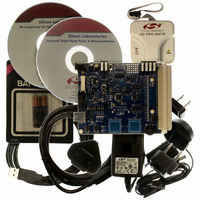C8051F930DK Silicon Laboratories Inc, C8051F930DK Datasheet - Page 152

C8051F930DK
Manufacturer Part Number
C8051F930DK
Description
KIT DEV C8051F920,F921,F930,F931
Manufacturer
Silicon Laboratories Inc
Type
MCUr
Specifications of C8051F930DK
Contents
Target Board, Power Adapter, USB Debug Adapter, Cables, Batteries, and Software
Processor To Be Evaluated
C8051F930
Processor Series
C8051F9xx
Data Bus Width
8 bit
Interface Type
I2C, UART, SPI
Maximum Operating Temperature
+ 85 C
Minimum Operating Temperature
- 40 C
Operating Supply Voltage
0.9 V to 3.6 V
Lead Free Status / RoHS Status
Lead free / RoHS Compliant
For Use With/related Products
C8051F920, F921, F930, F931
Lead Free Status / Rohs Status
Lead free / RoHS Compliant
Other names
336-1473
Available stocks
Company
Part Number
Manufacturer
Quantity
Price
Company:
Part Number:
C8051F930DK
Manufacturer:
Silicon Labs
Quantity:
135
- Current page: 152 of 324
- Download datasheet (3Mb)
C8051F93x-C8051F92x
13.6. Minimizing Flash Read Current
The Flash memory in the C8051F93x-C8051F92x devices is responsible for a substantial portion of the
total digital supply current when the device is executing code. Below are suggestions to minimize Flash
read current.
Note: Future 16 and 8 kB derivatives in this product family will use a Flash memory that is organized in rows of 64
152
bytes each. To maintain code compatibility across the entire family, it is best to locate small loops within a single
64-byte segment.
1. Use idle, suspend, or sleep modes while waiting for an interrupt, rather than polling the inter-
2. C8051F93x-C8051F92x devices have a one-shot timer that saves power when operating at
3. Flash read current depends on the number of address lines that toggle between sequential
rupt flag. Idle mode is particularly well-suited for use in implementing short pauses, since the
wake-up time is no more than three system clock cycles. See the Power Management chapter
for details on the various low-power operating modes.
system clock frequencies of 10 MHz or less. The one-shot timer generates a minimum-dura-
tion enable signal for the Flash sense amps on each clock cycle in which the Flash memory is
accessed. This allows the Flash to remain in a low power state for the remainder of the long
clock cycle.
At clock frequencies above 10 MHz, the system clock cycle becomes short enough that the
one-shot timer no longer provides a power benefit. Disabling the one-shot timer at higher fre-
quencies reduces power consumption. The one-shot is enabled by default, and it can be dis-
abled (bypassed) by setting the BYPASS bit (FLSCL.6) to logic 1. To re-enable the one-shot,
clear the BYPASS bit to logic 0. See the note in SFR Definition 13.3. FLSCL: Flash Scale for
more information on how to properly clear the BYPASS bit.
Flash read operations. In most cases, the difference in power is relatively small (on the order
of 5%).
The Flash memory is organized in rows. Each row in the C8051F9xx Flash contains 128
bytes. A substantial current increase can be detected when the read address jumps from one
row in the Flash memory to another. Consider a 3-cycle loop (e.g., SJMP $, or while(1);) which
straddles a 128-byte Flash row boundary. The Flash address jumps from one row to another
on two of every three clock cycles. This can result in a current increase of up 30% when com-
pared to the same 3-cycle loop contained entirely within a single row.
To minimize the power consumption of small loops, it is best to locate them within a single row,
if possible. To check if a loop is contained within a Flash row, divide the starting address of the
first instruction in the loop by 128. If the remainder (result of modulo operation) plus the length
of the loop is less than 127, then the loop fits inside a single Flash row. Otherwise, the loop will
be straddling two adjacent Flash rows. If a loop executes in 20 or more clock cycles, then the
transitions from one row to another will occur on relatively few clock cycles, and any resulting
increase in operating current will be negligible.
Rev. 1.1
Related parts for C8051F930DK
Image
Part Number
Description
Manufacturer
Datasheet
Request
R
Part Number:
Description:
SMD/C°/SINGLE-ENDED OUTPUT SILICON OSCILLATOR
Manufacturer:
Silicon Laboratories Inc
Part Number:
Description:
Manufacturer:
Silicon Laboratories Inc
Datasheet:
Part Number:
Description:
N/A N/A/SI4010 AES KEYFOB DEMO WITH LCD RX
Manufacturer:
Silicon Laboratories Inc
Datasheet:
Part Number:
Description:
N/A N/A/SI4010 SIMPLIFIED KEY FOB DEMO WITH LED RX
Manufacturer:
Silicon Laboratories Inc
Datasheet:
Part Number:
Description:
N/A/-40 TO 85 OC/EZLINK MODULE; F930/4432 HIGH BAND (REV E/B1)
Manufacturer:
Silicon Laboratories Inc
Part Number:
Description:
EZLink Module; F930/4432 Low Band (rev e/B1)
Manufacturer:
Silicon Laboratories Inc
Part Number:
Description:
I°/4460 10 DBM RADIO TEST CARD 434 MHZ
Manufacturer:
Silicon Laboratories Inc
Part Number:
Description:
I°/4461 14 DBM RADIO TEST CARD 868 MHZ
Manufacturer:
Silicon Laboratories Inc
Part Number:
Description:
I°/4463 20 DBM RFSWITCH RADIO TEST CARD 460 MHZ
Manufacturer:
Silicon Laboratories Inc
Part Number:
Description:
I°/4463 20 DBM RADIO TEST CARD 868 MHZ
Manufacturer:
Silicon Laboratories Inc
Part Number:
Description:
I°/4463 27 DBM RADIO TEST CARD 868 MHZ
Manufacturer:
Silicon Laboratories Inc
Part Number:
Description:
I°/4463 SKYWORKS 30 DBM RADIO TEST CARD 915 MHZ
Manufacturer:
Silicon Laboratories Inc
Part Number:
Description:
N/A N/A/-40 TO 85 OC/4463 RFMD 30 DBM RADIO TEST CARD 915 MHZ
Manufacturer:
Silicon Laboratories Inc
Part Number:
Description:
I°/4463 20 DBM RADIO TEST CARD 169 MHZ
Manufacturer:
Silicon Laboratories Inc











